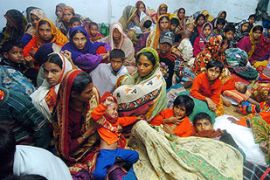Death toll rises in Bangladesh
Three towns flooded as more than 600 people are reported killed by cyclone Sidr.

Published On 17 Nov 2007
Communications and electricity have been cut to large parts of the south where village after village is said to have been destroyed.
While the massive evacuation that preceded the storm will have saved many lives, getting the hundreds of thousands home – or at least to what homes they have left – remains a daunting task.
Coastal areas hit
Gale force winds and five-metre-high waves hit low-lying coastal areas and offshore islands in the cyclone’s path.
Torrential rain also flooded some streets and stranded vehicles while strong winds sent billboards flying through the air in the capital Dhaka.
Sidr later weakened into a tropical storm and moved northeast across the country.
Skies remained overcast but wind speeds fell to 60km per hour, according to officials at the Bangladeshi meteorological department in Dhaka.
Cyclones, where water levels can rise above five metres, can cause immense devastation in low lying Bangladesh, a country of 140 million.
Nearly 10 million Bangladeshis live along the southern coast but the area has shelters for only about half a million.
A severe cyclone killed more than half a million people in 1970.
Relief effort
John Holmes, the UN undersecretary-general for humanitarian affairs, said the damage to livelihood, housing and crops from Sidr was likely to be “extremely severe”.
He said that the UN had allocated millions of dollars in aid to the affected region.
Nabiha Chowdhury, a spokesperson for the International Committee of the Red Cross (ICRC), said that government was better prepared in comparison with previous flood disasters.
“In terms of relief goods 400,000 water purification tablets have been sent to the affected coastal regions,” she said.
“We have also allocated funds to the affected regions to buy dry food for the people. In addition, mobile medical teams are on standby to assist the people who are injured and to provide them with medicines.”
Owen Fay, Al Jazeera’s correspondent in Dhaka, said people in the capital were considering themselves lucky that the damage from the storm was less than they first feared.
“Over the past few days, even as the storm surge swelled up to 10 metres in low-lying areas of the country, a massive relief effort was underway,” he said.
“This is a sharp contrast to what has happened to Bangladesh in the past.”
Official optimistic
Samarendra Karmakar, the meteorological department head, said the storm was as strong as the one in 1991 that sparked a tidal wave and killed an estimated 140,000 people.
But he said he was optimistic that a major effort this time to evacuate villages and place people in special shelters could mean Bangladesh would be spared a significant loss of life.
Vince Edwards from aid agency World Vision in Dhaka, told Al Jazeera that the extent of damage caused by the cyclone would become clearer in 24 hours.
“Houses and trees, 40-60 per cent have been damaged, crops due for harvest in December have been lost and there is going to be a serious impact on household livelihoods”, he said.
Source: Al Jazeera, News Agencies